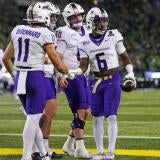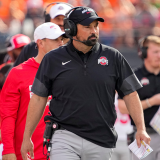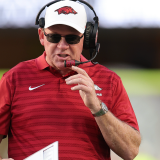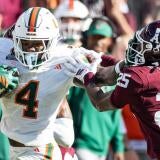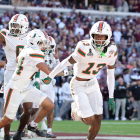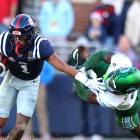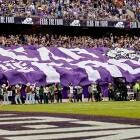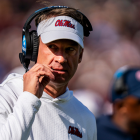2021 NFL Draft: Top 32 prospects overall based on their college football careers
Forget mock drafts, pro days and anonymous scouts, we're ranking players based solely on college performance

The week of the 2021 NFL Draft has finally arrived. After scouting prospects for years and spending way too much time breaking down pro day highlights, the next step has come for a promising draft class that has been through a college football season unlike any in modern history. With no NFL Combine, you would think that would only heighten the importance of what these players have shown on tape in college. Instead, we are lingering on hand-timed 40-yard dash numbers and the latest en vogue drill skill, which this year seems to be the off-platform deep throw.
It's an annual tradition to unveil this list here at the end of the process. This is not a mock draft, which leans heavily on team needs, nor a reflection of how we think a team's big board should look on draft night. This is a ranking for college football fans, meant to celebrate the best future pros before their playing careers change forever at the end of the week. We are ranking the top 32 players in the NFL Draft based on what they showed us college -- awarding excellence that has been, not what might be in the future.
As you'll see in the rankings below, there's not a ton of disagreement as it pertains to the top players in the draft class. But what I've found in over a decade of covering college football for CBS Sports and assisting with the NFL Draft coverage is that an exclusively college-centric approach to ranking players breaks from the NFL consensus in a few notable ways.
- Misplaced concerns with how a player "fits" at the next level: Just by earning an invitation to the NFL Combine, these players have outlasted cuts at every level and proven to be some of the most gifted football players in the country. There is an argument to be made for finding the right "fit" for a franchise or coaching staff, but when offensive and defensive players are downgraded because of how their size and measurables line up with a certain profile or expectation, I think mistakes are made in the evaluation process.
- Misplaced excitement based on measurables: The inverse of the "fit" concerns comes into play when NFL teams come back from the combine with testing numbers that overtake the evaluation process. Draft history factors into models and projections that use these numbers to inform decisions, but too often that can either overshadow the game film or contribute to bias and a new lens for reviewing a select player's performance. Testing well is a great way for a player to boost their draft stock and increase how much money can be made on their rookie deal, but players who have proven their performance at a high level on Saturdays tend to be the ones with intangibles that help them make it to a second contract.
- Draft value and scarcity: I understand the basic calculations that go into "a run on [position]" and why teams looking to address needs might choose to make moves or selections seeing that the number of high-end prospects at a certain position is starting to dissipate. I also generally disagree with passing on multiple best-player-available selections to address those needs.
Whether or not these players end up as 10-year pros, Pro Bowlers or even Hall of Fame-caliber players at the next level is dependent on far more than success in college, but what we have seen on Saturdays informs us plenty about talent and a player's competitive DNA. So with college performance as the building blocks of the rankings, let's dive into the top 32 prospects of the 2021 NFL Draft.
Want more college football in your life? Listen below and subscribe to the Cover 3 College Football podcast for top-notch insight and analysis beyond the gridiron.
1. Trevor Lawrence, QB, Clemson: Won a national championship as a freshman and lost only twice as a starting quarterback with both defeats coming in the College Football Playoff. The NFL crowd has been hyping up Lawrence for years based on his projections as a generational talent, but his college accomplishments alone would be worth this No. 1 status.
2. Justin Fields, QB, Ohio State: Critics who linger on poor showings against Indiana and Northwestern in 2020 are looking for reasons to pick Fields apart. Context, however, reminds us those are two of the toughest defenses in the Big Ten and the Buckeyes might have had a reason for looking out of sync in a delayed-but-rushed season with frequent changes to the lineups because of COVID protocol. In 2019, Fields became the first quarterback in Big Ten history with 40 passing touchdowns and 10 rushing touchdowns, and his 41-3 touchdown-to-interception ratio was the best in the country. That was his first year as a starter, and it alone gave us everything we needed to see to make him the No. 2 to Lawrence in the class.
3. Penei Sewell, OL, Oregon: In two full seasons of starting -- his freshman and sophomore seasons -- Sewell allowed just one sack in 1,376 snaps. He's been pro-ready for years and the kind of player you don't need to ask for a number when watching the tape. Now Sewell wasn't going to win the Heisman Trophy, but in a year where the "best player in college football" discussion extended beyond quarterbacks, Sewell could have easily been in the mix.
4. Ja'Marr Chase, WR, LSU: Ask opposing defensive backs from the SEC or recent College Football Playoff about the best wide receiver in this draft class, or even the last two draft classes. Chase has shown us everything we need to see and, like Sewell, was always destined to be in this position heading into draft week.
5. DeVonta Smith, WR, Alabama: Smith did not come out of high school with projections indicating much more than low first-round talent, so his rise up the boards is a credit to the hard work put in to improve and shine in an absolutely stellar season en route to winning the Heisman Trophy. What stood out about Smith's 2020 was in the details of his usage and production spike after Jaylen Waddle's injury. Steve Sarkisian moved Smith all around the offense and he found ways to excel thanks to a versatile skill set that makes him dangerous in any wide receiver room.
6. Kyle Pitts, TE, Florida: Some consider Pitts the best non-quarterback in the draft class. Based on what he could be, I don't think that's too bold. But we're ranking based on what we've already seen, and Pitts deserves to be among the top non-quarterbacks, but I give the edge to the two wide receivers from the SEC West.
7. Micah Parsons, LB, Penn State: It's too bad we didn't get to see Parsons as a return specialist in 2020 because any opportunities to see him with the ball in his hands would have only heightened the draft hype. His athleticism and instinctual play were so exciting to see in its infancy, but we know there's even more to come from Parsons.
8. Zach Wilson, QB, BYU: As one of the best quarterbacks in BYU history, Wilson will always have a special place in college football lore. His prolific playmaking in the Cougars 9-0 start to the season had both team and player among them most exciting stories in the sport. Things became noticeably more difficult for Wilson when they faced Coastal Carolina and San Diego State later in the year, similar to how things went in 2019 against the likes of Utah and Washington. So while we celebrate his successes, the proper college-centric ranking is behind Lawrence and Fields.
9. Mac Jones, QB, Alabama: In his only full season as a starter, Jones set the NCAA single-season record for completion percentage (77.4%) and became Alabama's all-time single-season passing leader. Since Nick Saban has given in to letting the offense cook, we may see more 400-yard passing performances in the near future. But as it stands, the Crimson Tide only have 10 in history and four of them came from Jones.
10. Jaylen Waddle, WR, Alabama: Bonus points awarded here for Waddle as one of the best return specialists in college football, which I assume is why some NFL teams reportedly consider him the top wideout in the draft. There are so few players who can make a difference in the open field like Waddle that his top-end route running and skills from the slot are just par for the course.
11. Zaven Collins, LB, Tulsa: Collins was the best defensive player in college football last season. He not only racked up tackles and tackles for loss, but seemed to always rise to the occasion with big-time playmaking in key situations. Collins had four interceptions in eight games, a forced fumble, a fumble recovery, a safety and ran one of those four interceptions 96 yards the other way for a game-winning touchdown in overtime against Tulane.
12. Patrick Surtain II, CB, Alabama: The Crimson Tide defense didn't rank up there statistically with the 2015 or 2017 title winners, but they did finish in the top 20 nationally in yards per play allowed thanks in part to having elite play at the cornerback position. Defensive coordinator Pete Goulding was able to dedicate extra eyes and bodies to the rest of the field knowing that Surtain, the. SEC Defensive Player of the Year with 38 career starts under his belt, had his assignment on lock.
13. Travis Etienne, RB, Clemson: The two-time ACC Player of the Year re-wrote the record books for career conference marks during a four-year run that included four ACC titles, four College Football Playoff appearances and two national championship games with one national title. But the most impressive stat is not his accumulated totals but the rate he carried throughout that four-year career, averaging 7.22 yards per carry. That's tops in ACC and school history, and No. 11 among all FBS players with at least 300 career rushing attempts. That 7.22 number is the evidence of explosiveness that terrifies opposing defensive coordinators when Etienne is on the field.
14. Najee Harris, RB, Alabama: As Alabama leaned more on its passing game to win a national championship, Harris was able to show off his ability to excel not only as a runner but as a receiving threat out of the backfield. A well-executed screen pass with Harris running behind the Tide's elite offensive line could turn into a touchdown easily thanks to his play-making in the open field.
15. Azeez Ojulari, DE, Georgia: The SEC leader in tackles for loss and sacks in 2020 took a huge jump from his redshirt 2018 season to emerge on the other side of 2019 as one of the Bulldogs' best players at any position. Georgia stacks top-end talent, especially on defense, but Ojulari has gotten better quickly to change from a top-150 kind of player in his class to potential first-round pick.
16. Kwity Paye, DL, Michigan: Paye is a phenomenal athlete, carrying his 6-4, 272-pound frame in a way that suggests he could play most positions on the football field. As he's continued to develop, the pro potential has been seen in flashes, and it's admittedly the ceiling that I'm using to rank him here rather than the base line. Michigan's defensive line had difficulty getting home with the pass rush last season in a year where Paye was expected to shine. He played in just four out of Michigan's six games, but still led the team in tackles for loss and was clearly missed when out of the lineup.
17. Jaelan Phillips, DE, Miami: Storming back from a retirement from football to achieve what many projected when he was a five-star prospect coming out of high school, Phillips' success shows one of the positive sides of allowing more movement with player transfers. A change of scenery helped the former UCLA linebacker get a second start, and he reshaped his body to become one of the most dangerous edge rushers in the country at Miami.
18. Jaycee Horn, CB, South Carolina: Horn shut things down for the season after seven games and the dismissal of Will Muschamp, but not before he was able to show his entire skill set during a dominant performance in a win against Auburn. Horn had three tackles, two interceptions and four pass breakups, earning Walter Camp National Defensive Player of the Week and SEC Defensive Player of the Week honors.
19. Rashawn Slater, OL, Northwestern: It's uncommon for Northwestern to trot out offensive line talent like Slater, which is why he became a mainstay of the Wildcats offense with 12 starts at right tackle as a freshman. He continued to develop and improve throughout his three-year career, opting out of the 2020 season in preparation for the NFL Draft.
20. Caleb Farley, CB, Virginia Tech: Some NFL folks seem to believe that Farley could give Surtain or Horn a challenge for the No. 1 corner taken in the draft. With speed and ball skills, boosted in part from his career as an all-state quarterback in high school at Maiden in Hickory, North Carolina, Farley led the ACC in passes defended and ranked second in interceptions (4) en route to earning first team all-conference honors in 2019.
21. Jeremiah Owusu-Koramoah, LB, Notre Dame: Player development on the defensive side of the ball at Notre Dame really improved under the guidance for former defensive coordinator (now Vanderbilt head coach) Clark Lea. Owusu-Koramoah is a prime example of that, starting on the scout team as a freshman, playing sparingly as a sophomore and starting every game while leading the team in tackles as a junior. Then, as a senior, he was an All-American and named Butkus Award winner as the best linebacker in the country.
22. Ronnie Perkins, DE, Oklahoma: We saw Perkins first flash as a freshman when he started seven of the final eight games of the year and finished as the team leader in sacks. He continued to be one of the team's primary pass rush threats and then his value to the Sooners was evident when he missed the first five games of 2020. Perkins has the kind of havoc-inducing length you love to see in an edge rusher, and that showed up in 10.5 tackles for loss and 5.5 sacks in the final six games of the year when he was in the lineup.
23. Joseph Ossai, LB, Texas: A consensus All-American and first-team all-conference performer in 2020, Ossai was the kind of versatile defender who could make the entire unit better. He was among the national leaders at the end of the season in tackles for loss, but he could also drop back off the line to defend passes or make plays in pursuit of a ball carrier in the open field. As one of the top talents coming out of the Houston area, there was always excitement about Ossai's potential with the Longhorns. In 2020, it felt like it all came together with him showing out as one of the best defensive players in the entire country.
24. Kadarius Toney, WR, Florida: While Pitts is deservedly getting the recognition as one of the top talents in the draft, Toney finished the season as the team's leader in receptions, receiving yards and receiving touchdowns. That's not only because Pitts missed time with injury, but also because Toney was finally able to put together a full season after battling injury in 2019. An all-purpose offensive threat that can be used in myriad ways, Toney was one of just four FBS players at the end of the regular season to record a game with two receiving touchdowns and one rushing touchdown.
25. Rondale Moore, WR, Purdue: If injuries had not played such a major role in Moore's college career, we're possibly discussing him along with Pitts and Waddle as inside receiving threats you can't pass up. And while Moore's explosion onto the season as a freshman sparks his inclusion in this list, I can't rank by college career and then have the Purdue star's stock boosted on potential.
26. Alex Leatherwood, OL, Alabama: When star left tackle Jonah Williams went down with an injury in the national championship game against Georgia following the 2017 season, then-freshman Alex Leatherwood was called upon early in the third quarter to help lead the Tide back from a halftime deficit along with fellow freshmen DeVonta Smith, Najee Harris and Tua Tagovailoa. While Tua and DeVonta are remembered often for the game-winning touchdown in overtime, I'll always celebrate Leatherwood stepping into that spot in a huge moment from the program and proving to be among the most reliable offensive line pieces of the Nick Saban era.
27. Daviyon Nixon, DL, Iowa: The best defensive lineman in the Big Ten, Nixon led the conference in tackles for loss and ranked fourth in sacks, earning unanimous All-American honors. Nixon was mostly a rotation player in 2019 with one start, but he made the most of his opportunity when his number was called in the offseason to be an anchor of the defensive line. Best highlight? How about watching the 306-pound Nixon move on a 71-yard interception return touchdown against Penn State.
28. Christian Darrisaw, OL, Virginia Tech: It was a disjointed start to the year for Virginia Tech, but the Hokies got off to a hot start with an impressive rushing attack. Khalil Herbert racked up all the yards, but experts were just as impressed with how the offensive line, with Darrisaw standing out, seemed to be mowing down defenders kept on their heels by a high-octane but physical ground attack.
29. Trey Lance, QB, North Dakota State: No one is going to argue with the quality of sample. There's no rebuttal for a 16-0 record as a starter while leading the Bison to a national championship just two years removed from high school with 28 passing touchdowns and zero interceptions. But the size of the sample and the quality of the competition has to be taken into consideration. I agree Lance is a first-round prospect; it's just hard for me to position him where he's landing in mock drafts because that would mean putting him ahead of players who have excelled at their own position for multiple years against tougher competition.
30. Greg Newsome II, DB, Northwestern: The Wildcats had one of the best pass defenses in the country last year -- another reason to look at that Fields analysis through a different lens -- and Newsome held down the veteran end of that group while Brandon Joseph starred as a freshman.
31. Rashad Weaver, DL, Pitt: After missing all of 2019 due to injury, Weaver returned to lead the ACC in sacks per game and tackles for loss per game en route to consensus All-American honors. Pitt has become known for its defensive line development, and Weaver adds to the narrative, arriving as one of the top two-way talents (defensive line, tight end) coming out of 7A ball in the Fort Lauderdale, Florida, area and leaving college as a pro-ready edge threat.
32. Landon Dickerson, OL, Alabama: After starting his college career at Florida State, Dickerson finished as one of the top interior offensive linemen in the country with the Crimson Tide. He was the Rimington Award winner as the best center in the country in 2020 after starting at both guard and center in 2019.


